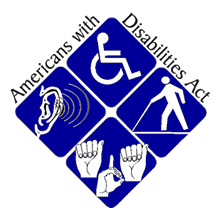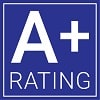What is the ADA?
ADA stands for the Americans with Disabilities Act. It provides regulations for businesses, governments, and public facilities to make sure they are as accessible as possible to every American, regardless of physical ability. The ADA provides rules, regulations, design standards, technical assistance materials, links to Federal Agencies, updates to requirements, informational videos, and enforcement activity updates.
The ADA law also protects Americans with disabilities from being discriminated against in workplaces, businesses, or public facilities. The ADA GUARANTEES equal and unrestricted access to public accommodations such as employment, transportation, government services, and telecommunications.
The ADA law also protects Americans with disabilities from being discriminated against in workplaces, businesses, or public facilities. The ADA GUARANTEES equal and unrestricted access to public accommodations such as employment, transportation, government services, and telecommunications.

The ADA law was signed by President George H.W Bush Sr in 2008 and became law on January 1, 2009. It did several things immediately, like change the definition of "disability" to be much more broad and encompassing.
CFR (Code of Federal Regulations), Chapter 35 is a chapter of the Code of Federal Regulations that deals with disabilities and discrimination. It states that any building building after 1992 MUST be readily accessible by individuals with disabilities.
The ADA 2010 is essentially a combination of the old 1992 ADA, updated with standards from CFR 35.151 to include preemptive measurements for buildings built in the future, and to grandfather some older construction projects into the ADA.
The Americans with Disabilities Act was most recently updated in 2010. It involved the integrations of several other disability advocacy laws that are now known as the ADA.
CFR (Code of Federal Regulations), Chapter 35 is a chapter of the Code of Federal Regulations that deals with disabilities and discrimination. It states that any building building after 1992 MUST be readily accessible by individuals with disabilities.
The ADA 2010 is essentially a combination of the old 1992 ADA, updated with standards from CFR 35.151 to include preemptive measurements for buildings built in the future, and to grandfather some older construction projects into the ADA.
The Americans with Disabilities Act was most recently updated in 2010. It involved the integrations of several other disability advocacy laws that are now known as the ADA.
What kind of plaques fall under the ADA regulations?
Most plaques and signs that assist in wayfinding, navigation, or general public assistance have to be ADA compliant. Signs like unisex restroom signs, men's bathroom signs, women bathroom signs, staircase signs, office door signage, and handicap accessible entrances and exits. All of these signs and plaques must feature ADA compliance.
How do I stay ADA Compliant in 2019?
Staying ADA compliant is important to keeping your property safe and to avoid different types of complications down the road. There are several factors considered the people behind the ADA were writing the legislation. Things like plaque mounting height, sign location, as well as different rules for overhead and projection ADA compliance plaques and signs.
Plaque Sign & Plaque Height
The baseline of the ADA compliance plaque or sign 48” at its’ lowest point and 60” at its’ highest. This range allows signs and plaques of different sizes to be mounted in this range and still be on the same visual plane. Elevators are excluded from this rule
ADA Sign & Plaque Locations
Signs should be mounted to the wall on the latch side of the door. If there is no room on that wall, the sign may be mounted on the nearest adjacent wall.
Overhead & Projections Plaques & Signs
The bottom of overhead signage must have clearance of 80”.
Projecting wall mounted signs must be a minimum of 27" from the foor and have a maximum protrusion of 4” into a pathway.
Signs should not interfere with or block any door function, emergency equipment or sprinklers.
Plaque Sign & Plaque Height
The baseline of the ADA compliance plaque or sign 48” at its’ lowest point and 60” at its’ highest. This range allows signs and plaques of different sizes to be mounted in this range and still be on the same visual plane. Elevators are excluded from this rule
ADA Sign & Plaque Locations
Signs should be mounted to the wall on the latch side of the door. If there is no room on that wall, the sign may be mounted on the nearest adjacent wall.
Overhead & Projections Plaques & Signs
The bottom of overhead signage must have clearance of 80”.
Projecting wall mounted signs must be a minimum of 27" from the foor and have a maximum protrusion of 4” into a pathway.
Signs should not interfere with or block any door function, emergency equipment or sprinklers.
Call now |
A Division of Advantage Signs & Graphics, Inc | Copyright © 2025 www.metalplaques.com | All Rights Reserved.




